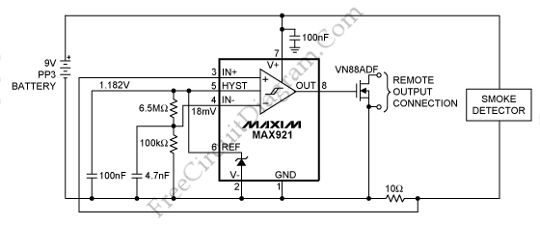Provide Remote Alarm for Smoke Detector

Ionization-based smoke detectors are efficient and cheap, so they are often installed in the house, other outbuildings, and the garage. The Locations of the device is far from house, so we need to transmit the alarm signals back into central home-security system or the house. This is a simple circuit that sense a supply current increase because activation of smoke detector’s internal alarm triggers it. Then this circuit will send a remote output to central security system or main dwelling to sound the alarm. Here is the circuit :

This circuit uses The MAX921 as comparator, because it has low supply current, internal voltage reference, and wide supply-voltage range. During monitor mode, the typical value of currents are 50µA and when the sounder is active, the current values are 3mA. This circuit receives power from the smoke detector’s battery. The output of this circuit is an open-drain FET, it can trigger an RF module that communicates or drive the home-security system back to the residence.
When the alarm is active, the voltage across the sense resistor is greater than 30mV. So the circuit trip point is set at 18mV. The hysteresis pin is connected for minimum hysteresis in the comparator, because the difference voltage between inactive and active operation is so great. To prevent false triggers, this circuit uses capacitor that will reducing the sensitivity to RF noise and noise. [Circuit diagram source: maxim-ic.com]